 This is a sketch of a site I found this weekend and I am sorry I did not explore that third bump. Note how most of the piles are to one side of the viewing position but with some outliers.
This is a sketch of a site I found this weekend and I am sorry I did not explore that third bump. Note how most of the piles are to one side of the viewing position but with some outliers.The best documented example of a grid site, which I consider an example of a marker pile site, is the one we surveyed at Spring Hill in Acton, MA
 We can look at this with fresh eyes and observe the nearly horizontal lines converging to the right. There is a hight point in that direction but I do not know if it lines up. There also might be high points in the other directions indicated by the families of parallel lines in the diagram.
We can look at this with fresh eyes and observe the nearly horizontal lines converging to the right. There is a hight point in that direction but I do not know if it lines up. There also might be high points in the other directions indicated by the families of parallel lines in the diagram.
3 comments :
I've always been interested in your marker pile hypothesis. So now that we have all these documented examples of grids and sight lines from higher points, the burning question now becomes, "Why?" What purpose did these markers serve? Are they ceremonial in nature? How were they related to spirituality? What kind of balance was being achieved by the creation of these linear examples?
Or are these perhaps a little less abstract and more utilitarian in origin? Are they representative of something cosmological? Are they symbolic of some past events? Are they related to the footprint of a long-ago winter hunting village?
Now that I know what I am looking for (and it is still only a hypothesis) I am going to try going back to some of the 100+ places I think this phenomenon is happening at, and maybe start bringing a compass with me; to see if certain directions are common at these sites. God forbid me if I am getting into alignments, something I have avoided up till now.
The presence of an occasional pile with a piece of quartz may give some insight into Jim's question.
Post a Comment